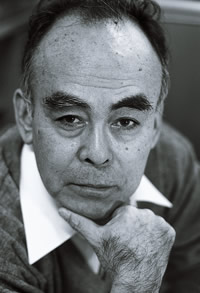 |
| A Shinshu boy interested in insects |
 |
 |
Matsumoto, where I was born and raised, is the perfect environment for a boy fascinated by insects. The starting point for me was when my primary school teacher took me to the Utsukushigahara Plain to catch butterflies. I was very impressed when I saw an alpine black swallowtail flying along a mountain road. From then until I was in high school I raised about 50 different local butterflies from eggs. I decided that if I was going to study, biology was for me, so I enrolled at the School of Science at Kyoto University. The first thing that happened at university was that I was impressed by the green-banded swallowtails, which are not found in Shinshu, on the campus camphor trees. I hatched dozens of eggs in my room.
My first class in zoology was taught by Hironori Ishizaki, currently a professor emeritus at Nagoya University. He brought newt and frogs’ eggs to class, told us to hatch them, observe them when and how we liked, sketch them, and submit a report one year later. I was very impressed at how different university classes were from anything else in my experience. I also studied ecology and anthropology, but I really enjoyed experiments and observation in embryology, so I joined the research lab of Professor Tokindo Okada, now an advisor emeritus at the JT Biohistory Research Hall. |
 |
| The mechanism linking the eye and the brain |
 |
 |
Prof. Okada was involved with two problems: the differentiation of individual cells, and creating colonies of cells. My first subject at graduate school was the former, but I was more interested in cell colonies, so I wondered what kind of research I would do as I spent my days reading reports.
I became interested in a report by the American researcher Marcus Jacobson, who stated there is a two-dimensional pattern in the connection between the optical nerve and the visual center in the brain. For example, the optic nerve, which extends from the dorsal area of the retina, is always connected to the ventral side of the visual center. I resolved to unravel this amazing mechanism that linked in an orderly fashion the eye and the brain, which are created separately.
I became an assistant at the Kyoto Prefectural University of Medicine, and I was assigned the responsibility for conducting classes and training in anatomy. This was beneficial for me, but I could not find the time to conduct research. Prof. Setsuya Fujita, now a professor emeritus at the same university, was on the same floor. I was impressed by his statement that neuroscience required a methodology in which complex things were dealt with in their complexity. My wish came true, and I was able to go abroad and study at Jacobson’s laboratory, but he changed the subject of the research to “The formation of brain circuitry is too complex”. |
At that time, there was no method for directly observing individual nerves. The only method was to insert an electrode into the nerve and examine it to see if the circuit was connected. Therefore, I developed a method for observing with a microscope the optic nerves of a newt that extended from the retina, using the technology for incorporating and coloring in a cell the enzymes that metabolize colored compounds.
In this method, I would sever the optic nerves, regenerate them, and then observe how they linked to the brain. My observations lasted several years. Unexpectedly, I discovered that the axons of the optical nerves migrated through repeated trial and error to the center of the brain, eventually arriving at the proper location. When I submitted a paper, a reviewer made the comment that this was “a piece of classic”. I made the hasty conclusion that my research was being denigrated as old-fashioned, but it was really an expression of praise for the research as being first class. It was placed in neuroembryology textbooks alongside the traditional research. I was very happy that my success had been recognized, though I had no personnel, time, or money. |
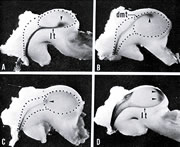
Using newts, I was the first to succeed in observing the projection pattern of optical nerves linking the eye and the brain. A, B, C, and D show the optical nerve growing to some location in the visual center (the area inside the circular dotted line) from the dorsal area, ventral area, nasal area, and temporal area of the retina.
|
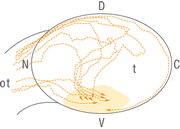
I cut the optical nerve from the retina of the dorsal area and observed the course of the nerve as it regenerated. After repeated trial and error, all the optical nerves ultimately arrived at the proper location. |
 |
| Observing organisms carefully |
 |
 |
Axons grow in the brain and migrate to the proper location in the visual center. This is undoubtedly because there is molecular communication between the axons and the brain cells. I discovered that there are different proteins in the destination of the axons and in other regions, and I studied their function at Nagoya University using the techniques of molecular biology.
I found that these proteins, which I named neuropilin and plexin, were important molecules for the formation of neural circuits. I continued the research I had thought of doing at graduate school, and finally arrived at molecular function.
When watching butterflies or looking through a microscope, I never get bored all day long. The primary activities of research are to collect a lot of information, think about it logically, and then verify it through experiments. Organisms, however, are equipped with complex and adaptable systems that far exceed anything we can imagine. Carefully observing organisms so as not to overlook the things we cannot imagine is both the beginning and the end. |
| There are many long-horned beetles on the tree-filled campus of Nagoya University. I like the ease with which I can make specimens, and the fact that they don’t take up much space. Now, as in the past, I am at ease when I am near insects. |
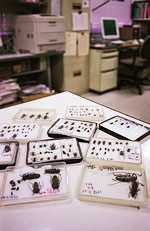 |
|
 |
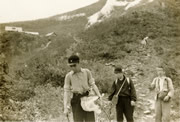 |
 On a collection trip during my first year at high school (I am on the left) On a collection trip during my first year at high school (I am on the left) |
 |
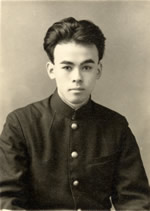 |
 My ID for the college entrance examination My ID for the college entrance examination |
 |
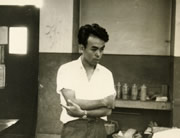 |
 During my second year of graduate school. I was thinking seriously about research. During my second year of graduate school. I was thinking seriously about research. |
 |
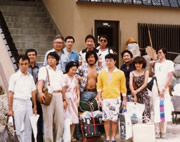 |
 On a class trip at the Kyoto Prefectural University of Medicine, where I had recently moved On a class trip at the Kyoto Prefectural University of Medicine, where I had recently moved
(I am on the far left)
|
 |
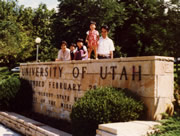 |
 I was invited to be a visiting professor at the University of Utah, where Dr. Jacobson was. This is a commemorative photograph with my mother and her three children. I was invited to be a visiting professor at the University of Utah, where Dr. Jacobson was. This is a commemorative photograph with my mother and her three children. |
 |
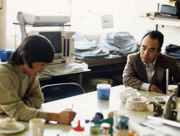 |
 A classroom at the Kyoto Prefectural University of Medicine. On the left is Harukazu Nakamura, currently a professor at Tohoku University. A classroom at the Kyoto Prefectural University of Medicine. On the left is Harukazu Nakamura, currently a professor at Tohoku University. |
 |
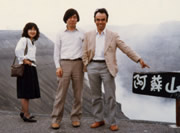 |
 This is the Kumamoto Society of Developmental Biologists. From left, they are Yoshiko Takahashi, now professor at the Nara Institute of Science and Technology; Masatoshi Takeichi, now director of the Center for Developmental Biology at RIKEN; and me. This is the Kumamoto Society of Developmental Biologists. From left, they are Yoshiko Takahashi, now professor at the Nara Institute of Science and Technology; Masatoshi Takeichi, now director of the Center for Developmental Biology at RIKEN; and me.
|
 |
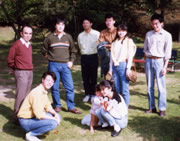 |
 These people started the research lab at Nagoya University. From the left in the front row are Takashi Kitsukawa, now an associate professor at Osaka University, and Tatsumi Hirata, now an associate professor at the National Institute of Genetics. I am in the back row on the left. Next to me is Atsushi Kawakami, now an associate professor at the Tokyo Institute of Technology. At the right in the back row is Shin Takagi, now an associate professor at Nagoya University. These people started the research lab at Nagoya University. From the left in the front row are Takashi Kitsukawa, now an associate professor at Osaka University, and Tatsumi Hirata, now an associate professor at the National Institute of Genetics. I am in the back row on the left. Next to me is Atsushi Kawakami, now an associate professor at the Tokyo Institute of Technology. At the right in the back row is Shin Takagi, now an associate professor at Nagoya University. |
 |
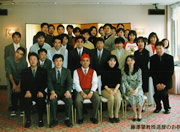 |
 Celebrating my 60th birthday Celebrating my 60th birthday |
 |
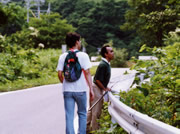 |
 Even for trips with all the lab members, I always specify a place where insects can be collected. Even for trips with all the lab members, I always specify a place where insects can be collected. |
|
